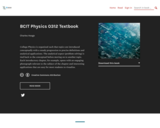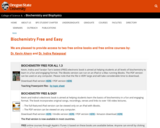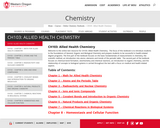
Arcade Expression Crash Course with COVID-19 data by Wing Cheung.
- Subject:
- Physical Geography
- Physical Science
- Material Type:
- Textbook
- Author:
- Wing Cheung
- Date Added:
- 06/15/2022

Astronomy, Atmospheric Science, Chemistry, Geology, Hydrology, Oceanography, Physical Geography and Physics.

Arcade Expression Crash Course with COVID-19 data by Wing Cheung.

Astronomy is designed to meet the scope and sequence requirements of one- or two-semester introductory astronomy courses. The book begins with relevant scientific fundamentals and progresses through an exploration of the solar system, stars, galaxies, and cosmology. The Astronomy textbook builds student understanding through the use of relevant analogies, clear and non-technical explanations, and rich illustrations. Mathematics is included in a flexible manner to meet the needs of individual instructors.

Astronomy for Educators provides new and accomplished K-12 instructors with concepts and projects for low-cost, high-impact STEM classroom instruction that is built around the National Academies National Research Council's K-12 Framework for Science Education.

Intended for all audiences, this textbook is an introduction to the nature of the universe. Use it to research or review our solar system, stars, galaxies, and the history of the universe. Each chapter has a set of corresponding homework questions.

Overview:
On this webpage you will find OER Chemistry textbooks along with supplemental materials and a few lecture videos.
The purpose of these discipline-specific pages is to display content that might be of interest to faculty who are considering adopting open educational resources for use in their classes. This list of content is by no means exhaustive. The nature of open educational resources is very collaborative and it is in that spirit that we encourage any comments about the content featured on this page or recommendations of content that are not already listed here.

College Physics is organized such that topics are introduced conceptually with a steady progression to precise definitions and analytical applications. The analytical aspect (problem solving) is tied back to the conceptual before moving on to another topic. Each introductory chapter, for example, opens with an engaging photograph relevant to the subject of the chapter and interesting applications that are easy for most students to visualize.

These Pre-Chemistry online modules are designed to function as chemistry preparation for first year chemistry students. It is particularly useful for students who, for various reasons, are otherwise not confident in their preparation for first year university level chemistry. However, the module can be used as a practical and valuable review for all students. The module focuses on the development of fundamental numeracy and problem solving skills that are widely applicable to students in a variety of first year chemistry courses including those directed to students in life science, engineering and natural and physical sciences. These modules function effectively in both online, hybrid or even as preparation for entirely traditionally delivered courses.

Climate change is an urgent problem. Because it is causing new weather extremes and fatal catastrophes, climate change is better termed climate disruption. Bending the curve to flatten the upward trajectory of pollution emissions responsible for climate disruption is essential in order to protect billions of people from this global threat. Education is a key part of the solution.

We are happy to welcome you to our second Open Educational Resource (OER) textbook, Biochemistry Free For All. Biochemistry is a relatively young science, but its rate of growth has been truly impressive. The rapid pace of discoveries, which shows no sign of slowing, is reflected in the steady increase in the size of biochemistry textbooks. Growing faster than the size of biochemistry books have been the skyrocketing costs of higher education and the even faster rising costs of college textbooks. These unfortunate realities have created a situation where the costs of going to college are beyond the means of increasing numbers of students.

This focused resource guide, "Black Lives in Astronomy," includes specific written and video resources about and by 25 black astronomers, as well as general materials to examine the history and issues facing black members of the astronomical community. It includes both older, established scientists and people early in their careers. It is aimed at the Astro 101 and amateur astronomer level, and thus does not include any technical materials. I hope this resource will give instructors and students examples of authentic black voices that can be shown in class or used in assignments.

Body Physics was designed to meet the objectives of a one-term high school or freshman level course in physical science, typically designed to provide non-science majors and undeclared students with exposure to the most basic principles in physics while fulfilling a science-with-lab core requirement. The content level is aimed at students taking their first college science course, whether or not they are planning to major in science. However, with minor supplementation by other resources, such as OpenStax College Physics, this textbook could easily be used as the primary resource in 200-level introductory courses. Chapters that may be more appropriate for physics courses than for general science courses are noted with an asterisk symbol (*). Of course, this textbook could be used to supplement other primary resources in any physics course covering mechanics and thermodynamics.

There are many, including my environmental and civil engineering technology students, who do not have decades to commit to developing a working understanding of the Earth and the specific geological and geomorphological contexts they may find themselves working in. Therefore, this textbook is designed to provide a brief introduction to the concepts of geology and geomorphology, with an Ontarian perspective. It serves as a good starting point for individuals who have neither prior experience nor knowledge in geology nor geomorphology. In order to adequately explain concepts that unfold in four dimensions (3 dimensions with time as the fourth), an electronic format is used to leverage enhanced illustrations. These illustrations include traditional 2D figures; however, videos, animations, and interactive figures are also used to help create a deeper understanding.

This first year Geography textbook takes a holistic approach to Geography by incorporating elements of physical, human and regional geography, as well as bringing in methods and perspectives from spatial information science.. This textbook applies a fundamental geographical approach to understanding our globally changing world by looking at local processes which are linked to larger global processes and events. For example mining and its effects are a global issue and we can see how these unfold in BC. A further example is the recent apology to First Nation peoples on the residential school treatment, as similar events occur in the US, Ireland and Australia. Processes of urbanization, a phenomenon which people all over the globe are experiencing, can be seen in Vancouver with our discussion of the citys development. Geography students, indeed all first year students, need to be able to critically assess their own contexts and environments in order to properly engage with our continually globalizing world.

Introduces chemistry related topics pertaining to everyday life. Includes topics such as renewable energy, clean air and water and global climate change using a relatively nonmathematical approach. Includes atomic/molecular structure, the periodic table, chemical bonding, intermolecular forces, chemical reactions, acids/bases and the social and environmental role of chemistry. Recommended for non-science majors to fulfill the Gen Ed science with lab requirement.

The focus of this textbook is to introduce students to the foundations of General, Organic and Biological Chemistry and prepare students to be successful in health-related degree programs. The first part of the textbook focuses on the basic fundamentals of measurements in chemistry, the scientific method, an introduction into atoms, elements and trends of the periodic table. The second part of the textbook focuses on chemical bond formation, stoichiometry and chemical reactions, an introduction to organic chemistry, and the relationship of concepts to biological systems is carried throughout the text with a focus on medical and health-related aspects.

The focus of this textbook is to introduce students to the foundations of General Chemistry and prepare students to be successful in the CH221-222-223 majors level chemistry series. The first part of the textbook focuses on the basic fundamentals of measurements in chemistry, the scientific method, an introduction into atoms, elements and trends of the periodic table. The second part of the textbook focuses on ionic and covalent compounds and their nomenclature, an introduction to chemistry reactions, stoichiometry, and solutions chemistry. Within each chapter, there is also a section entitled ‘Focus on the Environment’ that provides students an opportunity to learn and engage with environmental issues and concerns in the context of scientific studies and chemistry concepts. Within these sections are suggested written and discussion assignments that are appropriate for use in an introductory college-level course in chemistry.

This textbook is an adaptation of the Saylor Introduction to Chemistry book customized for CH 104 at Central Oregon Community College. Low-cost print available: http://www.lulu.com/shop/forrest-towne/introduction-to-chemistry/paperback/product-24034383.html
Upon completing this course students will:
Interpret the periodic table to describe elements of atomic structure for the elements and to make predictions about properties based on the position of elements on the table.
Apply atomic theory in describing atomic structure, making predictions about bonding and compound formation, and interpreting chemical reactions.
Construct and interpret Lewis structures as models for ionic and covalent compounds.
Describe ionic and covalent bonding and distinguish between the two, including descriptions of substances of each type at the observable scale.
Solve problems using dimensional analysis involving chemical substances and reactions, drawing on understanding of the mole concept, formula masses and reaction stoichiometry.
Read, write, and interpret balanced chemical equations, using proper equation syntax and standard symbolism to link such descriptions to phenomena that occur at the observable scale.
Interpret and carry out a set of written experimental instructions and then to convey the experimental results in a laboratory report.
Apply kinetic-molecular theory to describe solids, liquids, and gases.
Recognize acids and describe acidity according to the Bronsted-Lowry definition.
Use scientific (inductive) reasoning to draw appropriate conclusions from data sets or theoretical models. Characterize arguments as scientific, or not scientific.
Make measurements and operate with numbers properly to convey appropriate levels of certainty when drawing conclusions from experimental data. Identify patterns in data by graphical means.

Welcome to the online text resource for CH105: Consumer Chemistry. The focus of this textbook is to introduce students to the fundamental applications of organic chemistry to society, technology, and the development of consumer products. The first part of the textbook focuses on the basic fundamentals of measurements in chemistry, the scientific method, and an introduction into atoms and elements. The second part of the textbook focuses on an introduction to organic chemistry and how it is applied to our daily lives. Topics include fuels and energy, polymers, fertilizers, pesticides, food and food additives, household cleaners, cosmetics and personal care items, pharmaceuticals, and air and water pollution. Organic concepts covered include an introduction to intermolecular forces and solution dynamics, VESPR and molecular geometry, organic structure and basic chemical reactions.

The focus of this textbook is to introduce students to the foundations of General Chemistry and prepare students to be successful in the CH221-222-223 majors level chemistry series. The first part of the textbook focuses on the basic fundamentals of measurements in chemistry, the scientific method, an introduction into atoms, elements and trends of the periodic table. The second part of the textbook focuses on ionic and covalent compounds and their nomenclature, an introduction to chemistry reactions, stoichiometry, and solutions chemistry.

An introductory to chemistry textbook for incoming college students to gain a strong foundation.
This textbook covers:
1: Introduction to Chemistry and the Scientific Method
2: Measurement and Significant Figures
3: Dimensional Analysis and Density
4: Classification of Matter- Properties and Changes
5: The Nuclei of Atoms
6: Ions, Ionic Bonding, and the Nomenclature of Ionic Compounds
7: Molecules, Covalent Bonding, and the Nomenclature of Binary Covalent Compounds
8: Counting Atoms, Ions, and Molecules
9: An Introduction to Chemical Reactions
10: Mass Relations in Chemical Reactions